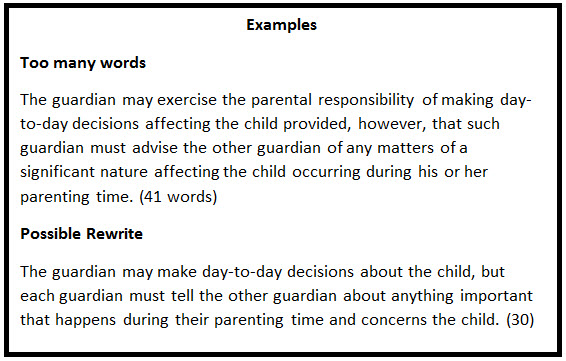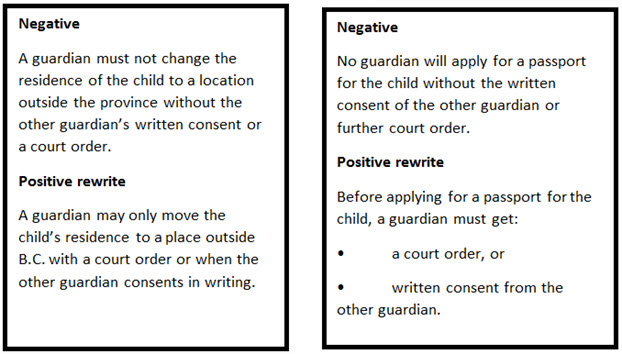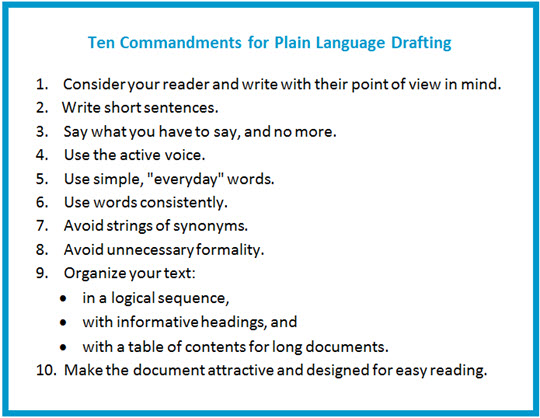Speaking and writing in plain language doesn’t mean using only two-syllable words or “dumbing down” your message. It doesn’t force you to omit complex information. Instead, it involves analyzing what you want to say to determine what information your audience needs, organizing it logically, using words at a level your audience can understand, and presenting it so it’s easy to read.
This eNews outlines some evidence-based plain language guidelines that have been proven to work well in legal writing, suggested by plain language legal writing pioneer Cheryl Stephens.
Use a simple sentence structure
The simplest step to improve your writing is this: Start with an actor and spell out who does what to whom; then state when and where. Called the legislative sentence, it can be used as often as possible. So the best, simplest structure is: Subject — Predicate — Object — Modifiers.
The mother will pick up the child from daycare every Thursday.
Use shorter sentences.
On average, sentences should be 15 – 25 words long. Break a long sentence into two or more. Add periods at natural pauses.
Cut extra words

Don’t hide the verbs
When a verb is turned into a noun, it can be used as a subject or object. But a reader must use extra effort to process a verb that has been turned into a noun. For readers, the verb is easier.
• If they had made a decision→ If they had decided...
• The lower court ruling that → The lower court ruled...
Take it easy with passive verbs
Verbs have voice, most commonly active, passive, or reflexive.
• Active-voice verbs express action: Someone sent the particulars too late. The subject of the sentence is the actor or doer. Active-voice verbs are easier for the reader to process—the action can be immediately visualized.
• Passive-voice verbs focus on the thing or person concerned: The particulars were sent too late. A trick for telling if a sentence is passive is to add “by zombies” at the end. If it makes sense, you’ve probably used passive voice.*
• Reflexive-voice verbs use an adjective to describe or refer back to the subject: The particulars were late. Reflexive voice usually requires the help of some form of the verb to be.
The passive voice can hide the actor’s identity. That’s why the legislative sentence is preferred in law. We want to know who is responsible for doing or failing to do something.
Try to avoid negatives, conditionals, and exceptions.
• State the basic principle first, then the limitations or conditions.
• Avoid putting things negatively.
• Don’t put in layers of negativity.

A sentence with conditionals (if …, then …; unless …, then …; when …, then …) and exceptions is difficult to process, especially when those are at the front of the sentence. This is called a left-handed sentence. Use right-handed sentences and structure the conditions in a list when possible.
Break it up, add white space, & use lists
Break up long paragraphs with white space and bulleted lists. Add descriptive headings to guide readers and define content (Did Mr. X apply force to Mr. Y? Was Mr. X acting in self defence?).
Lists should contain related items - generally not more than four. Break up longer lists by creating subcategories. Readers expect hierarchical cues to priority or importance.
In plain language style, you number items on a list only if doing so shows steps, time-sequence, priorities, or values. If a court order must have numbered items, group and organize related items.
Using too many lists in a document looks choppy but readers also complain about dense text. So use shorter sentences, lists, and white space in the page layout.

Don’t let fear hold you back
Plain language processes and techniques – its writing-style guidelines-- simplify and clarify writing to be understood by the people affected and serve a modern world that is more diverse than ever. And when it comes to tone, legal writers are not limited to the frozen, static tone common to legal drafting. Effective legal communicators can sound like a real person using a conversational yet dignified tone.
If the language is plain and the meaning is clear to a general audience, a judge is unlikely to criticize a lawyer, and an appeal court unlikely to criticize a trial judge. In Plain Language Legal Writing, Cheryl Stephens disposes of the hypothetical perverse judge whom most lawyers expect to face, by quoting from an earlier work:
“Let’s forget about Judge Fiendish. Let’s write so that no reasonable man will misinterpret what we’re trying to say.”
How to Write Plain English, Rudolf Flesch, New York: Harper & Row, 1979

Learn more
• Find sensible rules and ridiculous prohibitions in Learn the fundamentals of writing first—experiment later, by Bryan A. Garner, ABA Journal, July 1, 2017.
• Get a jurist’s point of view from Judge Mark P. Painter of the Ohio First District Court of Appeals: Legal Writing 201: 30 suggestions to improve readability or how to write for judges, not like judges.
• Read Chapter 9, “Clarity”, on judicial writing in The Appellate Craft by J. E. Côté, Justice of the Alberta Court of Appeal, for the Judicial Council.
• See which guidelines are supported by the research, and which are not: Plain Legal Language: the underlying research - a 2012 review of 500 research articles by Karen Schriver (save time by starting with slide #30.)
* Katherine Spivey, Plain Language Action and Information Network, June 2017 Meeting

